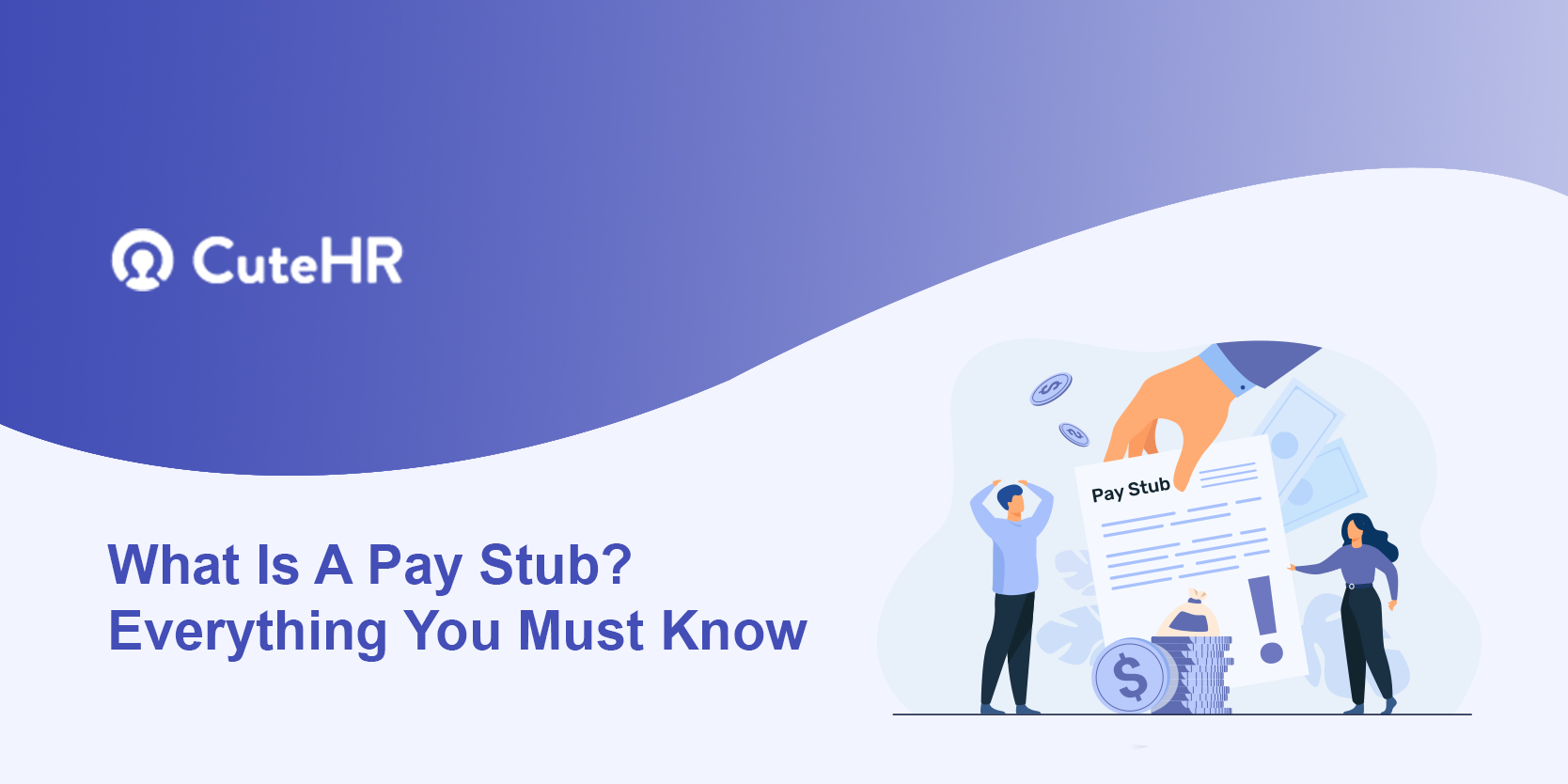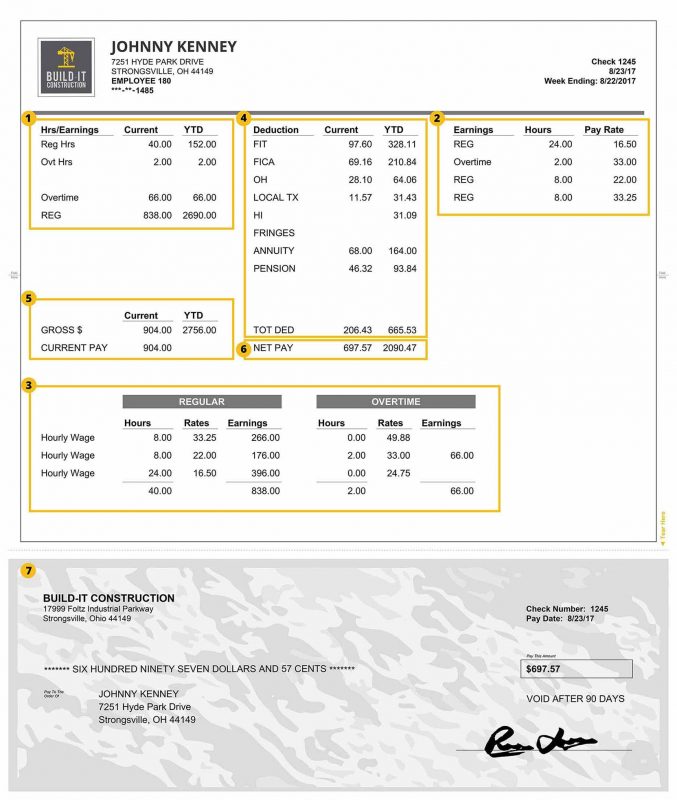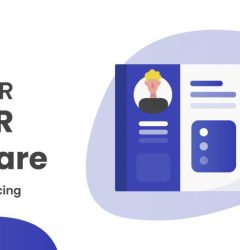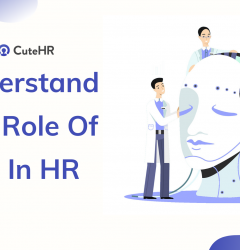17 Feb

Pay Stubs are nothing but the documentation that you need to provide to the employees while paying their wages. It communicates all kinds of calculations applied to the final paycheck between an employer and the employee with full transparency. Details include salary paid to the employee, all kinds of taxes paid, and deductions removed. An employer needs to have the knowledge of all the terms on a pay stub to explain the payroll taxes and other deductions to their employees. Basically, pay stubs allow employers to keep a clear record of payroll information. It is a very convenient method by which employees can easily understand that how much they’ll get paid.
Table of Contents
What Is A Pay Stub?
A Pay Stub is a part of an employee’s paycheck that itemizes important figures like employee wage, taxes, and deductions.
It displays the details of calculations applied to the final paycheck. A pay stub is a very important document because it is the only official paperwork that creates transparency about the job done and the money paid for it.
The mandatory information to be displayed on a pay stub varies according to the state’s policies. It can be a physical bill or an online form as well. A copy of the pay stubs can also be kept for the company’s payroll records.
What Are Pay Stubs Used For?
Employees receive pay stubs as a record of their salaries and hourly wages. Pay stubs help the employees to understand and analyze all the taxes and deductions and check if they are paid correctly by the company.
On the other hand, an employer can use the pay stubs as proof to settle any pay discrepancy issues with the employees. It also helps the company to solve any questions from the government bodies or the state regarding an employee’s pay.
Things To Be Included On A Pay Stub
A pay stub provides a set of information related to the employee’s final pay. It is provided to the employee along with the paycheck. Given below are some set of information that is included on a pay stub.
1. Pay Period Start and End Date
It represents the starting and ending dates of the pay period. This subsection is very important for salaried employees as they receive the same amount of money for a specific time frame. Mostly, companies follow a monthly or bi-weekly paycheck pattern of which the start and end date of that period are mentioned in this topic of the pay stub.
2. Pay Rate
The Pay rate (also known as wage rate) is that employee’s rate of pay for their particular job. It shows how much the employee is paid on an hourly or salary basis.
3. Number Of Hours Worked
This represents the number of hours the employee worked during that pay period.
4. Other Compensation
If the employee earns a bonus, overtime or receives holiday pay like the same as regular pay, everything is itemized under this subsection on the pay stub. Remember that the pay rate, hours worked, and net pay is distinctly mentioned on a quality pay stub.
5. Net Pay
The net pay of an employee is the final in-hand amount or rather the amount mentioned on their paycheck or directly deposited into their bank account as their salary. It is the total amount minus taxes and other deductions. Usually, both the current net pay as well as the year-to-date net pay are mentioned on a pay stub. This also helps the employee to understand their pay and check for accuracy. The net pay might be significantly lower than the gross pay depending on the size of deductions.
6. Gross Earnings
It is the full amount that an employee makes before deductions or taxes are levied. This pay is often more than the employee’s regular salary. Any extra income earned such as bonuses, payroll advances, or overtime pay are included under the gross earnings section. The method of calculation of the gross earnings is different for hourly and salaried employees.
- Salaried Employee: This is calculated by dividing their annual income by the number of pay periods in that year.
- Hourly Employee: The gross income for an hourly employee is calculated by multiplying their hourly pay rate by the number of hours they worked.
7. Year-To-Date Payroll Earnings
This topic of the pay stub represents the total sum of money that an employee has earned from the beginning of the year (1st January) till the current date.
8. Withhold For Federal, State and Local Taxes
Taxes are often listed as a deduction on an employee’s pay stub. These withhold amounts to the total taxes that the employee has to pay to the federal, state, and local bodies. The federal income tax is the most mandatory tax, also considered as “pay-as-you-go tax”. Therefore this tax is directly collected from the paycheck and sent to the IRS regulatory. Usually, the contractors are responsible for withholding the taxes.
9. FICA Tax Deductions
Federal Insurance Contributions Act (FICA) is a law that mandates a payroll deduction with every pay period of an employee. These collected taxes are used to fund Social Security and Medicare. FICA tax rates are fixed by the Internal Revenue Service (IRS).
10. Deduction For Benefits
Other deductions depend on the small/large business employee benefit provided by your organisation. Benefits commonly include insurance premiums or retirement plans. The contribution for these benefits is withdrawn from the paycheck before other taxes. However, these benefit deductions vary depending on the employer and the company’s policies.
11. Contribution
The money contribution for benefits by an employer or an employee is also needed to be itemised on a pay stub. Contribution from the employee’s side may include payment of FUTA tax, SUTA tax, FICA tax, 401(k) etc. Contribution from the employer’s side may vary depending on the benefit opportunities provided.
The contribution from the employer’s side is itemised as a portion of an employee’s gross wage whereas, a contribution from the employee’s side is deducted from their paycheck. Each contribution should be distinctly itemised on the pay stub.
12. Wage Garnishments
An employer is chosen to garnish wages by the government. The employer subtracts any money owed, like owed income taxes or failed to repay loans, and sends it to the government on the employee’s behalf.
Some of the important acronyms and abbreviations that are usually found in every pay stub are:
- FT or FED is Federal Tax
- FICA is Federal Insurance Contributions Act
- ST is State Tax
- SS is Social Security
- EIN is Employee Identification Number
- OT is Overtime
- MWT (sometimes referred to as Med) is Medicare
How Does A Pay Stub Look?
If you are thinking, “How does a pay stub look like”, an example of an excellent pay stub is given below :

Pay stubs generally incorporate information on both the employee (by providing details like name, address, and social security number) and the employer(by providing the name and address of the organization/business). Pay stubs differ as per the industry requirements and the state employment laws. Each portion in a pay stub must be uniquely identified. Here are some components that can help you to create a decent pay stub.
1. Business Information
A pay stub must include the company’s business information. Details like the name of the company and its business/headquarters location will do.
2. Payroll Company Logo
The company’s logo on the pay stubs can help to enhance and make the pay stub more original. These minute details can have a huge influence.
3. Employee Information
All the important details of the employee like name, phone number, social security number and home address on a pay stub. Tax allowances can be included on a pay stub as well.
4. Pay Period/Pay Date
It is mandatory to show the pay period (Employee is paid from what date to what date?) and include the payment date as well.
5. Hours and Earnings
How many hours the employee worked in that particular time period, and how much amount it results in gross pay.
6. Tax Deduction
This is the section where all the taxes and its calculation needs to be shown. The pay stub should include both the current deductions as well as the year-to-date deductions. The deduction is very important to be itemized on a pay stub so that the employees can see the amounts reduced from their gross pay.
7. Other Withholdings
The pay stubs may also include the employee’s contribution in any extra withholds (if any). This can also include what the employee contributed to those categories, however, it is an optional component.
8. Payroll Earnings
Payroll earnings must be at the end and a little distinctive from the rest of the other components. It needs to show the earnings, deduced amount and net pay.
How To Create A Pay Stub?
There are multiple ways by which a company or small businesses can create a pay stub. With the help of software services, you can very easily create some of the finest pay stubs without much effort. If your company is falling back and not able to implement its tactics due to the idea of manual calculation of wages, taxes and deductions, outsourcing a job specifically for pay stubs might be beneficial.
The software services differ by the features offered and their pricing. There is much well-known software that provides fab pay stub services that integrate your POS and time-tracking system.
There are also many free online tools and templates that can be used if you don’t want the much expensive full payroll programs of the above websites. Some programs provide subscription-based services whereas some charge per stub.
Are Pay Stubs Required By Law?
The Fair Labor Standards Act (FLSA) makes it mandatory for the employer to keep and save the precise records of the hourly wages and salaries of their employees for up to three years. Here the role of pay stubs comes into the picture as it meets all the requirements of the FSLA act, but it is not required at a federal level. However, it is mandatory to submit a pay stub in twenty-six states and additional eleven states that require pay stub documents in physical/paper form. Every state has different legal requirements.
Even if the pay stubs are not provided to the state regularly, an employee has full authority to access the payroll files, which the employer can’t deny. This is because the government finds it suspicious if any company/business does not offer transparency around the wages of the employees. Therefore, all the states vary in their pay stubs requirements, but the employers must be ready to show the payroll documentation whenever asked.
For instance, New York’s state council requires food business to include a section for tips and wages earned on each pay stub. If the employer provides meals or uniform, that must also be included on the pay stub under the “credits” or “allowances”.
The eleven states that require a physical/paper pay stub documentation are:
- California
- Colorado
- Connecticut
- Iowa
- Maine
- Massachusetts
- New Mexico
- North Carolina
- Texas
- Vermont
- Washington
States other than these do not require information to be provided on paper. Employers can send the information electronically provided that all the employees have access to it.
How Long Should Be The Pay Stubs?
The employers should retain copies of the employees’ pay stub or payroll for at least 4 years. This is because the Internal Revenue Service (IRS) requires employees to “keep records of employment taxes for at least four years after filing the [fourth] quarter for the year.”
Other rules according to the Fair Labor Standards Act (FLSA) and the Age Discrimination in Employment Act (ADEA) has made it mandatory for employers to hold the pay stubs or payroll records of the employees for at least three years. Along with the payroll records, employers must also keep the records showing job evaluations, wage rates, seniority, and merit system. This is stored to clarify the basis of paying different wages to employees of the opposite genders working under the same organization.
The final government agency that requires employers to preserve their employment records is the Equal Employment Opportunity Commission (EEOC). According to the commission, employers must keep the records one year past an employee’s termination date if that employee let go involuntarily.
All the information that is required to be preserved goes beyond just pay stubs. Still keeping a record of the pay stubs and payrolls periods is very beneficial for the office environment and the relationship between the employees with their employers.
Why Is A Pay Stub Important To Include With A Payroll?
Pay stubs are not required at the federal level, but they may be a mandatory legal obligation at the state level. Excluding the legal proceedings, a pay stub can be an important aspect of the employer-employee relationship. Pay stubs can help an employee in almost all financial decisions and transactions. Situations like applying for loans, access to housing or other financial aids requires a pay stub as proof of employment.
Such situations are very stressful for an employee.
An employer can assist in easing such stressful situations by making it easy for the employees to access the required details, which are provided on a pay stub. Pay stubs can also be very handy to highlight and fix any kind of error regarding the payroll and bring it to attention. It also helps to identify if an amount is extraordinarily low or high and save the company from the IRS penalties and conflicts with the employees.
Pay stubs are like receipts for the employees and provide liability to your business. These can also clarify an employee’s questions regarding taxes, withholdings, net pay, etc. Employees must always make sure that the pay stub displays the exact values and other necessary information.
Frequently Asked Questions (FAQS)
Is a pay stub the same as a paycheck?
A paycheck is a bank check or electronic direct deposit that is given to an employee by their employer to pay them for their work. It does not include anything more than just the amount. However, a pay stub is a document that communicates all kinds of calculations applied to the paycheck between an employer and the employee with full transparency.
How do I get pay stubs?
An employee’s pay stub can be obtained by visiting the company’s payroll department on your own or by searching for it online. Both methods can help you find the calculations applied to your final income. You as an employee are allowed to ask your employer where you can find your pay stub, ask for copies of your pay stubs from the department or find it on your company’s website (if any).
What if your employer doesn’t give you a pay stub?
If an employer refuses to give paystubs, the employee has a right to sue in a court of law to obtain those records from the employer and may be eligible to penalties for not giving the pay stubs. The possible penalties may vary depending on state law. If you are seeking the pay stub for a specific purpose, make sure you let your employer know about it.












Himani